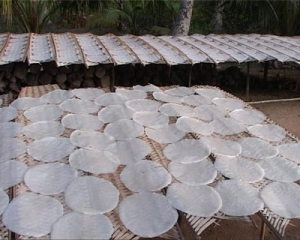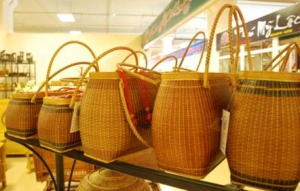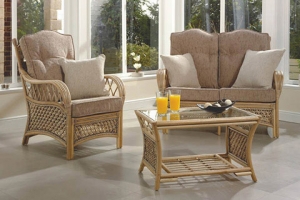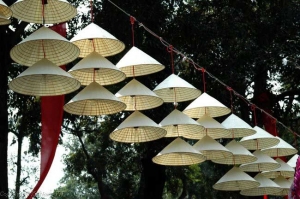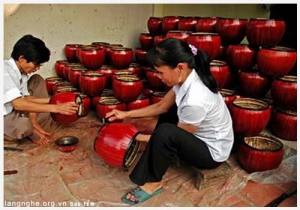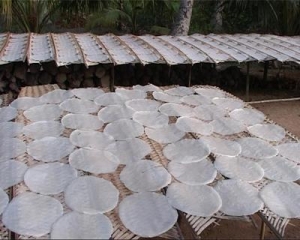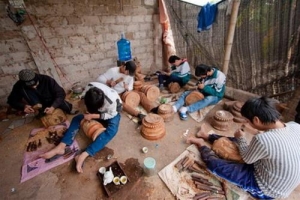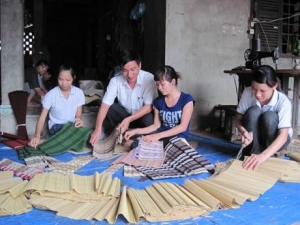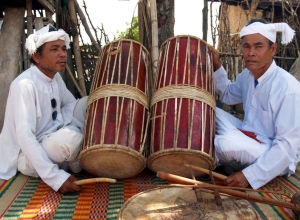
Asia Pacific Travel Team
The Ricepaper Village of Hoa Da
Like other villages in Phu Yen, the people in Hoa Da hamlet, An My commune (Tuy An district) mainly live on the rice plants, and also from this abundant material resource, ricepaper-making has long appeared here and become their traditional occupation passed through many generations up to now.
Hoa Da rice paper has long been famous for the special flavour of its ingredients, the products are consumed not only in the district market but also in many other places in the country.
Beside the ricepaper village of Hoa Da, Phu Yen also has many other ricepaper villages with the same quality such as the ricepaper villages of Dong Binh, Dong Phuoc, Hoa An, Phu Thuan . . . This is also the special dish that Phu Yen people usually give to their relatives, friends as presents.
The Village of Handicraft and Fine Arts
With the material resource of banana fibres and rattans available in the local area, through the hands of skillful workmen in the occupation villages of Vinh Phu, Phu An, An Nien, Dong Phuoc (Hoa An commune, Phu Hoa district) and My Thanh, Dong Loc (Hoa Thang commune, Phu Hoa district)
Do Xuyen Rattan and Bamboo Village in Phu Tho
It is not as busy as other traditional craft villages in Hong River delta region. The endurance and quietness have made Do Xuyen become a traditional craft village with unique products.
Today, the occupation of chap bamboo production has further developed thanks to the investment by Hon Ngoc Vien Dong Ltd., Company. The products of Do Xuyen village of bamboo dishes, bowls, and chopsticks have been sold in foreign markets. Do Xuyen people have not only had chance to restore traditional occupation but also get richer.
Palm leaf conical Hat Occupation in Phu Tho
Phu Tho is land of palm trees so the development of conical hat occupation is inevitable. However, for many last years, the hat production of the province has been in small-scale. Unlike conical hats of Chuong village in Ha Tay province or Hue�s city lata-nia leaf hats, Phu Tho conical hats characterize by simplicity, harmonious lines, durableness and reasonable price.
In recent decade, Sai Nga is biggest conical hat production in the region. The village has become a workshop bustling all day with production processes of leaf cutting, ironing, designing and hat sewing.
A good hat is a hat with beautiful and even sewing lines and flat surface. A verse of poem, or a picture is placed in between two layers of thin leaves.
Simplicity, white and long-wearing is Song Thao conical hat.
Those who travel here and there, visit Song Thao wearing beautiful hats.
U am Son Vy (Teapot warm keeper) in Phu Tho
Have you ever stopped in a small shops in roadside to sip a cup of tea in freezing winter?
Son Vy, a small village of Lam Thao district, Phu Tho province is native land of the unique product. The occupation of producing teapot warm keepers has been in Son Vy Village for more than 100 years passing many period of rises and falls. With the artistic and skillful hands, the villagers have created the teapot warm keeper with unique design. Each teapot warm keeper is a familiar utensil of each family around the year.
Son Vy - teapot warm keeper was awarded silver medal in the National Handicrafts And Fine Arts Products Fair. If the product would have had more decoration and attractive design, economic value of Son Vy teapot warm keepers will be increased and vitality of the traditional craft village will be long lasted.
Doan Ket food processing village in Phu Tho
Doan Ket Hamlet of Hung Lo commune, Phu Ninh district has been well-known for processing Mien (glass noodle), My (rice noodle), bun (rice vermicelli) and rice paper sheets for hundreds of years. The hamlet's products haven't been yet given trade name but they have won customers' trust with quality.
For years, the craft village has been existing humbly and tenaciously. If don't coming to see with your own eyes, you can not imagine the bustling working of grinding workshops and many generations of Hung Lo people grow up by the occupation. Production of glass noodle and rice noodle don't require big investment so any household can run the business. Dozens of years ago, the production process did by hands but at present, it is replaced by machine so the productivity have been raising. A household can produce 200-300 kg per day. Therefore, Hung Lo commune supplies dozens of tones of dried food of Mien, rice paper sheet to market everyday.
Minh Duc Carpentry Occupation in Phu Tho
Talking to carpentry, people first think about Dong Ky village in Bac Ninh province or La Xuyen Village of Nam Dinh province. The economic value of these craft villages reaches to billions of Dong. But many small-scale carpentry villages have been existed to make life more beautiful.
Minh Duc wooden products have been sold in every corner of the country from rural to urban areas. Naming the trade mark of product by the name of the village is a wish of villagers. With the efforts of local authorities and villagers and support of customers, the dream will come true soon. And it is also a basic for Minh Duc wooden products to approach international market and integrate into the development country's wooden product industry.
Tang Tien Bamboo and Rattan Craft Village
From a distant view, Tang Tien village is looming under bamboo hedges, mixing into green fields flooded with sunlight. The old village lane takes you to houses with mossy tiles and to famous master craftspeople on the Cau riverside.
Indigenous to the countryside of the Northern Delta area, two kinds of bamboo called Giang (ampelocalamus patellaris) and Nua (neohouzeana dulloa) are very much a part of the lives of the villagers. Nothing is so flexible and soft as neohouzeoura string, and nothing is so familiar with villagers as are baskets, screens… but how to split the dexterous string of those bamboos is an art of Tang Tien, a commune belonging to Viet Yen district, Bac Giang province.
Distinguished from other craft villages, the Tang Tien people concentrate on improving only their traditional products such as baskets and screens from generation to generation. The young generation accumulated the most quintessence from the previous generation, and then continued to make creative progress for better products. As for their concentration only on traditional products, Tang Tien dominates the niche of nice quality baskets. If you come to Tang Tien today, you will find interesting attractions in the form of all kinds of baskets even from the simplest one. Under the talented hands of Tang Tien villagers, bamboo splints are so smooth regardless of the bark or core parts, big or small, and the quality is consistent in any household able to make the same nice baskets of a light green and soft fragrance of natural bamboo.
When visitors are enjoying the lively scene whereby all members of the family from the old, the children, and the young are weaving expertly in the eaves, next to a small yard full of baskets laid for sun drying, you will probably pay attention to the clattering coming from somewhere. Yes, that is the sound emanating from the manual looms of the Tang Tien people. Please do not miss the chance to admire the soft bamboo screens made of micro bamboo splints, so thin as a strand of hair and about one meter (one yard) long, significant considering they are all split by hand. It is not going too far to say that the bamboo screen is so unique here. This is an excellent combination between the traditional weaving skill and special workmanship required in the making of micro bamboo splints.
A Japanese customer, who used to supervise production at Tang Tien for some time, expressed his satisfaction: “It’s marvelous; we have been importing baskets from Tang Tien for nearly three years, and our customers are very fond of these products.” Besides penetration into Japan, they are now available in America and some of the EU. Among five hamlets of Tang Tien commune, many households are making bamboo wares, and nearly 100% of the households in Phuc Long commune are in this craft, altogether creating about 2,000,000 products a month with annual exports of more than 1,000,000 US dollars.
From the raw material of natural bamboo, Tang Tien villagers have been weaving their nice dreams of a bright future.
The echo of the Baranung drum
For the skin of the Baranung, which is played by hand, they would use the skin of a male goat with horns 3 to 5 cm long or a female goat that had given birth seven times.
A painstaking craft
In the village of Hau Sanh, located at the foot of Po Ro Me Tower, I was welcomed by Phu Sang, who is the oldest drum artisan there. “Without drums, our festivals would lose their spirit and without the spirit of the festival, the Cham would forget who they are,” he said.
Sang‘s 60-year career started at the age of 15 when he joined his uncles in making drums for local people. At the time wood and animal skins suitable for making drums were plentiful. He and his uncle favoured ironwood, hog plum and shroea obtuse because these types of wood can be used for a long time without cracking, but today this wood is becoming rare enough to find.
For the skin of the Baranung, which is played by hand, they would use the skin of a male goat with horns 3 to 5 cm long or a female goat that had given birth seven times. For the Ginang drum, which is played with hardwood drumsticks, they would use the skin of the Giant Muntjac, preferably a male with black feathers. The skin of the shoulder should be used to make the drum sound more resonant.
Making these drums requires specific technical skills. For example, the string used to stretch the drum head should ideally be cut from the skin of a buffalo with 50cm horns. After it is cut, it must be stretched until it dries along with added salt and ashes for elasticity and durability. Finally, they must decide the length of the drum, which may vary depending on who is to play with. The Ginang normally measures 78cm in length and 60cm for beginners. For the Baranung, 50cm is typical.
However, a traditional pair of Ginang drums must differ by a few centimeters. The bigger drum is placed on the left and represents the female element. It produces deeper sounds and is called thetrong ba (grandmother drum). The smaller one is placed on the right and represents the male element. It produces higher sounds and is called the trong ong (grandfather drum). The two Ginang and one Baranung produce three distinct tones when being played together in performance.
Connected with the spirit of the drums
“Every time I make a set of drums, I have to give an offering to the deities and the founders of the craft so that they will protect and assist me. The offering includes three chicken eggs, one bunch of bananas, one bottle of wine and one dish of betel and areca,” said Sang.
The most difficult task for him is to restore old drums, some of them hundreds of years old. “I have to invite the shaman to call up the spirits of the drums,” he continued, “Only after that do I dare fix them. Hardly is there anyone under sixty who dares to make this type of drums.”
Sixty two-year-old Thien Sanh Thiem, another drum artisan from Huu Duc Village, explained to me that this is because Cham musical instruments are full of symbolic meaning. Each set represents a whole person, complete with spirit and emotions.
The Saranai clarion has seven holes, symbolizing a human head with two eyes, two ears, two nostrils and one mouth. The Baranung drum symbolizes a body, the twin Ginang drums are two legs, and the drumsticks are the arms. Finally each Ginang drum skin has sixteen holes through which a string is run to hold it to the body. Two drums bring the total of holes to thirty-two, the number of teeth in a human mouth.
In order to play well, each drummer must connect his spirit with the spirit of the drums. According to Thiem, “If you strike the drum in a superficial way, it will sound out of tune. Playing the Saranai clarion is similar. It sounds completely different from a tower or the stage in a festival. The difference lies in the ability to connect with people’s souls.”
Sang added that “In some villages, there are six sets of drums but no one knows how to play.”
The legend remains
Sang is still strong enough to make about five sets of drums a year. Looking back over sixty years of his craft, he said with regret that none of his children are keen to carry it on. Instead, they all plan to become carpenters, which will bring them more money.
He now lives with his wife in an old house, where he has welcome many foreign reporters and researchers in a tiny room stuffed with drum-making tools. But what makes him most happy are the village festivals and ceremonies. Though he is exhausted after a week-long performance he knows it is still worth it in the end.
“I teach the children how to play drums and clarions,” he said, “so that they can play in my funereal.” His words give me a pang of sympathy, but they are the words of a Cham who conceives of death as simply a trip to the other world.
Thiem has also received an invitation to teach Cham musical instruments in Hanoi. He continues making drums for museums in cities like Hanoi, Binh Dinh, Quang Nam, Phu Yen and An Giang and is very proud that all of his five sons are trying to carve out a good career for themselves by following in his footsteps.
He, in turn, has completed his own father’s wish: “Do not let this craft die, for when there is no longer a Cham song to be heard from villages or towers, there will be nothing left to identify the soul of the Cham people.”
Kite Installation Arts
Kites are considered as the symbol of peace and desire of freedom. In celebrating Thang Long – Hanoi 1000th Anniversary, a kite fête at Hue Festival 2010 will be held with various displaying activities like kites installation art, procession of kites or being incorporated in the traditional long dress show at the two ancient capitals - Hue and Hanoi and stop-over localities in between the two cities which were landmarks of Vietnam’s capital over the history


